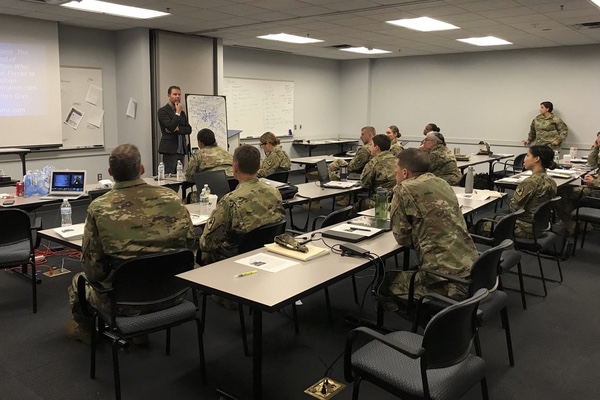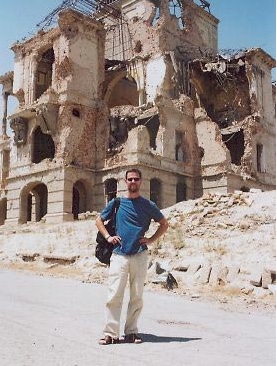The Historian Who Went to Work for the CIA to Combat Terrorism

Brian Glyn Williams speaking to the Army’s 3rd Legal Operations Detachment about his book The Last Warlord.
Related Link At the Last Minute the ISIS Captor Had Lowered His Demands and We Had Rescued Fayza from Certain Death in Mosul By Brian Glyn Williams
"The West will not contain Communism; it will transcend Communism.” Ronald Reagan delivered these words in a 1981 speech at Norte Dame University, a speech that would come to define the mission of his presidency as he set out to win the Cold War. President Reagan made it clear what he believed: that America stood for a good idea, the Soviet Union for a bad one. As a teen coming of age in 1980s Brian Glyn Williams was drawn by Reagan’s message of the moral inferiority of communism, becoming a self-professed Cold War warrior. With the Soviet incursion in Afghanistan ramping up, the Mujahideen became the latest freedom fighters armed by the CIA to combat the Russians. Williams, who is now a Professor of Islamic History at University of Massachusetts-Dartmouth, came to admire these rebels including Massoud (“The Lion of Panjsheer”).
Having peered through dozens of articles and news clippings on the situation in Afghanistan, nothing other than first-hand experience could quench Williams’s thirst for knowledge on the issue. On a trip that would shape the trajectory of his life, Williams traveled to the USSR in the final years of the Cold War and for the first time encountered Turko-Mongol Muslim Uzbecks, a nomadic group from central Asia. Amongst a crowd of uniformly black clad Russians at a Moscow train station appeared an Uzbeck family comprised of a grandfather with a long beard and bright green silk coat and a group of women wearing bright jackets and red headscarves. Mesmerized by their beauty, Williams would come to describe this moment askismet, the Arabic word for destiny or fate, as it was from that point that Williams developed his ambition to become a CIA case officer.
While completing his doctorate in Central Asian Islamic History at the University of Wisconsin, Williams led students on historical journeys of Central Asia, deepening his own interest in region and its culture. From there, Williams took a position at UMass Dartmouth as a professor of Ottoman and Mongol Empire history. During his academic tenure, Williams carved out a rare niche for himself as a recorder of the extraordinary events of the early 21th century that propelled US forces across the globe from Niger to the Middle East. Not limiting himself to the comforts of libraries and lecture halls, Williams has been able to foster this specialty with, as Williams describes it, “boots on the ground fieldwork.” As a historian, Williams has always been guided by the idea that his scholarship requires immersing himself in the lands he studies. This has meant at times interacting with those making the history he’s writing about. That engagement and willingness to put himself in harm’s way defined the first decade of his career as an educator, qualities that would come to attract the attention of the CIA.

As the War on Terror was widening to the various corners of the globe, the CIA sought to expand its Counter Terrorism Center. Specifically, the Agency needed individuals with the cultural knowledge required to form relationships with potential assets, and the willingness to conduct dangerous fieldwork in the middle of a warzone. Under the command of Generals David Petraeus and Stanley McChrystal, there was a new interest in historical approaches to counterinsurgency focused on understanding the human terrain of theaters of war. Recognizing that “you can’t kill your way out of an insurgency,” these commanders had a deep hunger for historical information that could help the military in winning the hearts and minds of the civilians on the ground. In 2007 the CIA bought out Williams’s UMass contract and recruited him to help combat the emergence of a new phenomenon: alien Arab suicide bombings. Along with Williams, the military recruited several other civilians, including anthropologists and linguists, to uncover the historical details not otherwise available on the Internet. Only a few years before joining the CIA, Williams predicted that suicide bombs would become the terrorists’ weapon of choice. He presented this theory at a conference at Columbia University only to receive widespread condemnation from those in attendance. In a short period, Williams was, unfortunately, proven correct as suicide-bombing attacks became ubiquitous across the Middle East.
During the course of Williams’s dangerous fieldwork for the Agency in the Taliban-dominated provinces of eastern Afghanistan, he worked to unravel the Iraqi origins, distinctly Afghan targeting patterns, localized ideology, geographic parameters, cultural responses, and unique bombing techniques of Taliban suicide bombers who were devastating Afghanistan in the world’s largest istihadayeen(“those who become martyrs in self sacrifice”) killing campaign. In other words, his mission involved historicizing a terror campaign, as it was actually unfolding, for a government agency that was concerned enough to hire a civilian historian to explain the contours of this deadly new phenomenon.
Williams’s field research led to several breakthroughs, most notably his insight that Afghan suicide bombers from the dominant Aryan Pashtun ethnic group had the lowest kill ratio of any suicide bombing campaigns in the world. The reason for this, as Williams came to learn, was that the Pashtunwali warrior code inclined them to go for hard military targets instead of soft civilian targets of the sort Iraqi, Chechen, Palestinian, Al Qaeda and Hezbollah bombers aimed for. Williams’s findings were presented in debriefings and helped inform the strategies of the troops on the ground, potentially saving lives. In fact Williams’s groundwork, which involved interviewing survivors in the immediate aftermath of a suicide attack, created the foundation for the CIA’s new suicide bombing database/matrix for Afghanistan.
Putting aside the inherent risk associated with such work, conducting this fieldwork did not come without its fair share of challenges. As Williams explains, “the most difficult part was getting subjects in remote and undeveloped Islamic lands to retell their stories in an ordered, linear, chronological fashion of the sort we Western historians are trained to record.” Most of Williams’s time on the ground was spent “meeting people in various war zones and earning their trust or at least encouraging them to open up to me.” Those personal interactions were integral in developing a profile for the CIA of suicide/homicide bombers in the Afghan theater of operations. In developing that profile, Williams came to understand the religious component underpinning many of these attacks, a fact that was often overlooked or dismissed by some mainstream pundits and academics. In connecting religion with this form of terrorism, Williams noticed a tendency on the part of his colleagues “to inadvertently become Islamic apologists and express the notion that somehow jihad and terrorism … are somehow not really a part of Islam.” As Williams came to conclude, the “vast majority of these killers had been given religious training/indoctrination by mullahs, imams and priests” and “this immersion in the Islamic faith made them [terrorists] more susceptible to calls to put on vests filled with TNT.” However, as Williams warns, his findings are not an indictment of all Muslims, as there are vast numbers across the globe “fighting and dying to defeat the fanatics from within their faith across the world” including Williams’s personal hero, Massoud, the Lion of Panjsher, who died fighting against extremists.
Looking back at his experience, Williams appreciates the unique opportunity he had as a civilian historizing a terror campaign as it was happening. As Williams describes it: “I was a rare historian working in this war zone and my chosen focus as a historicizer of the current War on Terror events gave me the ability to chronicle the rise of this new tactic and other phenomenon related to America’s longest war.” Throughout his career Williams has been willing to do what others wouldn’t or couldn’t in furtherance of his research, becoming the first historian to chronicle his war zone experiences for major foreign policy journals and think tanks. Today Williams is one of the few “eggheads” in academia to enjoy a broad base of support from the military and intelligence communities,including endorsements from former CIA Director David Petraeus and National Security Advisor Richard Clarke. Now a professor, Williams passes on a message imparted to him by his parents: the one book required to understand world history is a U.S. passport.
You can find out more about Brian Glyn Williams at his website.
